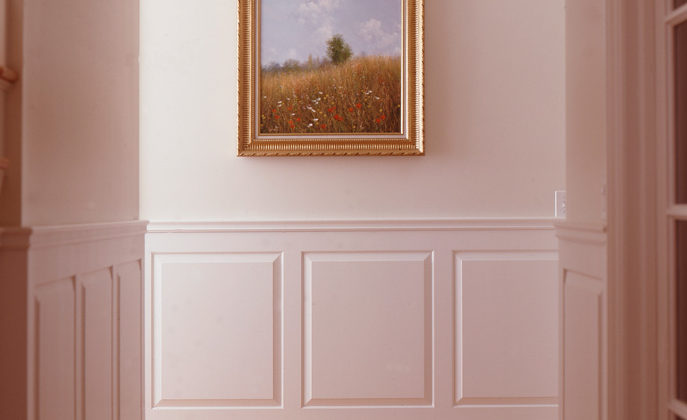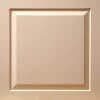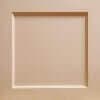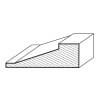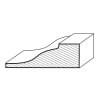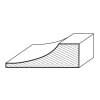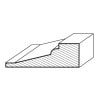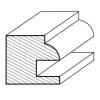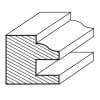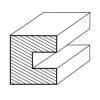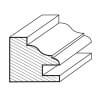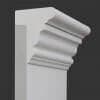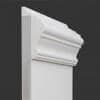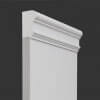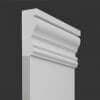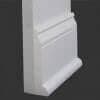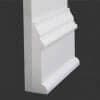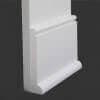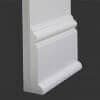There are many elements to determining the correct height for wainscoting. Wainscoting has been in our interior design repertoire since its inception in 14th century Europe (there’s debate as to whether it’s English or Dutch in origin). There are many different styles out there and each style can have their own height requirements, but most people will be familiar with the classic raised panel wainscoting. A common question that many have before installing wainscoting in their home, is what is the ideal height for it to come up the wall?
Here is a look at the different heights you could install wainscoting, and how they may affect the aesthetics of your home.
Considerations
There are a few things you may need to consider before even looking into what kind of wainscoting you want in your home. They are spatial, pre-existing fixtures, and aesthetic style.
Height for Wainscoting: Spatial Considerations
First and foremost, you want the wainscoting to compliment the space you have, not clash with it. There are a couple of elements to spatial considerations which are relevant to each room: the height of the room and the amount of space in the room.
The height of the room should be amplified by the use of wainscoting, so if you have tall walls, you may want to use whole wall wainscoting to break up the monotony of the bare wall. Whereas if you have a shorter room, the use of wainscoting at a third of the height of the room, with contrasting wallpaper or color above it can help to transform how that space feels.
The amount of space in the room will dictate the type of wainscoting that is most appropriate, as some kinds, like raised panel wainscoting, may take up more space than other kinds like beadboard. This is why considering height for wainscoting is equally as important as picking the right style for your home.
Height for Wainscoting: Pre-existing Fixture Considerations
The next consideration is about the pre-existing fixtures in any of the rooms you’re considering wainscoting for. These fixtures will either have to be worked around, or accented through the smart application of wainscoting.
The following fixtures typically suit being accented by wainscoting:
- Fireplaces – whether in the lounge or in your bedroom, a fireplace looks great with the right kind of wainscoting on either side.
- Stairs – if you’ve ever seen wainscoting on a stairwell, you’ll know it’s an opportunity not to be missed. The triangular shape of a stairwell looks great with the boxing of wainscoting.
- Doors – if you’re wainscoting an entire room, you may find that the doors suddenly contrast the walls in a strange way. Consider finding doors which contrast or compliment the wainscoting with their own raised or flat panels.
Height for Wainscoting: Aesthetic Style Considerations
While most kinds of wainscoting, especially raised panel wainscoting, are considered classical styles, they can suit more contemporary homes too. In fact, there are styles of wainscoting that can suit any kind of house, with classic wainscoting looking great in a beach house, and hardwood beadboard looking great in a cabin. Be sure to explore all of the different possible wainscoting styles that may suit your home before you decide, and remember to either compliment or contrast if you don’t want to clash.
When in Doubt, The Rule of Thirds
For all things visual, there’s a rule which dictates what will be most aesthetically pleasing. If you’ve ever learnt anything about photography, you may be aware of the rule of thirds. The rule of thirds, simply put, is the idea that by splitting a scene into 3 equal parts, one will achieve the most aesthetically pleasing appearance.
Applying this to Wainscoting
When it comes to wainscoting, applying the rule of thirds is simple. Start by measuring the height of the chosen room in which you will be installing wainscoting, and divide it by 3. For example, if your room is 9 feet tall, then your wainscoting should come up to 3 feet. Of course you don’t have to stick to exactly a third, a few inches either side won’t affect it too much. Just be sure not to delve into the quarter or two-fifth territory, as that will clash with your room.
For a whole wall wainscoting, you may want to apply the rule of thirds to the entire wall, with 3 equally sized panels running up the height of the wall.
Looking for help with your next big wainscoting project? Contact Wainscot Solutions today!
Faux Wainscoting vs. Authentic Wainscoting | What is Wainscoting? |
